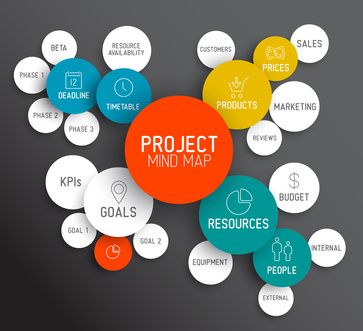Workflows
How to Choose the RIGHT Project Management Methodology

Project managers play a huge role in their organizations. In addition to managing multiple projects, many project managers are also responsible for improving, developing, and executing a new project management process.
Developing a new project management process requires much more than simply understanding and recognizing organizational priorities.
Project managers must also have a deeper understanding of key project management methodologies (PMMs), and how each one may or may not provide value to a project and the organization as a whole.
Although there are a number of PMMs in use today, this doesn’t mean that every PMM is the best fit for every organization. Choosing the right project management methodology has everything to do with organizational and stakeholder needs as well as the types of projects delivered.
Therefore, choosing a PMM can have a positive impact on the organization. Conversely, choosing the wrong methodology can derail the organization’s chance of project success.

So, how do you ensure that you choose the right project management methodology for your organization?
Keep reading.
What Are the Different Project Management Methodologies?
The good news is there are different types of project management methodologies to choose from.
The bad news is… there are different types of project management methodologies to choose from, and this only adds another layer of complexity.
The most popular PMMs include the following:
-
- Scrum
-
- Agile
-
- Waterfall
-
- Hybrid
-
- Kanban
-
- Traditional
-
- Critical path
-
- Critical Chain Method (CCM)
- Six Sigma
 Why Your PMM Usually Fails…
Why Your PMM Usually Fails…
Many project managers (and non-project managers by trade) spend time researching or reviewing case studies of how a particular PMM worked for one company.
As a result, they may adopt the “latest and greatest” PMM and techniques, thinking they will be the best solutions.
However, more often than not, this ends up increasing complexity that the organization cannot handle, which inevitably results in failure.
Not only does the PMM itself fail, but the company forfeits all the costs spent on education, training, and implementation.
Here are the top reasons why your PMM usually fails:
- Complexity. Many project managers and organizations take a scientific approach to selecting a PMM. They research various PMMs, and read various case studies of how a particular PMM worked for a specific organization. In an effort to achieve similar success, project managers adopt the same PMM, only to discover that it added more complexity to the process rather than simplified and streamlined it.
- Too Much Process. Many project managers believe that process is the key to success. Yes, building an efficient process is important, but too much process can further complicate things and even elevate risks.\
- Department and/ or organizational challenges. Although adopting a new PMM may seem like a good idea, many project managers often run into department and organizational challenges. Many of these challenges include acquiring a larger budget for adoption, getting executive-level managers on board, and other organizational culture and politics.\
- Teams underestimate the work and effort involved. **Think about it… Without ever working with a particular PMM—how do you know it will actually work for your team and organization? In many cases, project managers will adopt a PMM only to discover that it adds even more work and requires more time, effort, and resources than what they can afford.**What is Involved in Choosing the Right PMM?**The best way to go about choosing the right PMM is to develop a process. This process should assess and document the type of PMM selected, and how it will be implemented and used within the workflow. This can be time consuming, but worth it in the end.
When evaluating the right PMM for your organization, here are a few factors to consider: -
- Stakeholders
-
- Organizational values, goals, and objectives
-
- Project drivers and constraints
-
- Level of risks and likelihood of occurrence
-
- Level of complexity
-
- Types of projects
- Project size and costs
When choosing the right project management methodology for your organization, there are some priority considerations. First and foremost, the selected PMM should be the best choice *for your team.*Adopting any PMM requires education, training, and team participation. Therefore, when selecting the right PMM for your organization, it’s also important to consider the amount of training and education needed to get your team on board.
Project Management Methodology Assessment Process and ToolsOnce you have determined the criteria in which to base your decision, the next step is to develop a process to help you identify the best PMMs.
It’s important to remember that this process requires ongoing maintenance and development. It’s rarely ever set in stone.
It’s also a good idea to revisit the process occasionally, and update and modify as needed.
Here are some steps on how to build and develop a process:
-
Identify. The first step is to identify project drivers and constraints, primary goals and priorities for each project, and how projects would be impacted by each PMM.
-
Assess. Then, assess the most relevant methodologies that would be the best fit for your organization. Compare and contrast each PMM.
3. Determine. Next, determine the PMM that will provide the best results and outcomes as well as the least amount of risk.
4. Collect. Gather feedback from team members and organization members on the selected PMM.
5. Document. Document the PMM, process, and workflow.
6. Execute. Execute the process according to the documentation. Train team members as needed.
7. Modify and Revisit. Modify and update as needed as organizational and stakeholder needs evolve.
As we mentioned briefly above, each PMM isn’t always the best option for every organization. One organization may benefit from a particular PMM over another.
Furthermore, each PMM has pros and cons. In fact, some organizations may decide to take a “hybrid” approach, implementing various methods and techniques from multiple PMMs. All in all, it is crucial to approach each PMM with the organization, team, and stakeholders in mind.
** What is a Visual Workflow and How Does It Work?**Today, many project managers and organizations are discovering the benefits of building a simple visual workflow and foundation. A visual workflow is a project management technique that can be easily adapted by any organization and implemented in any project.
What is a Visual Workflow and How Does It Work?**Today, many project managers and organizations are discovering the benefits of building a simple visual workflow and foundation. A visual workflow is a project management technique that can be easily adapted by any organization and implemented in any project.
One of the primary reasons why visual workflows work so well is their level of visualization. A visual workflow provides a simple, clear, top-level view of all the steps involved in a particular task or process, removing complexity from a project. A visual workflow is also easy to learn, adopt, and implement. It requires little to no tools, setup time, or training.
Implementing a visual workflow allows project managers to build a solid foundation for improved communication, information exchange, resource allocation, problem solving, short and long-term planning and increased productivity.
Although the visual workflow is relatively easy to implement, taking half the time as some other PMMs, some professional project management experience is required. An experienced project manager will be able to effectively identify, assess, and weigh the pros and cons of each methodology in order to determine the best one for the team, organization, and stakeholders.
Develop a Process for Your PMM
In summary, we have outlined the most popular project management methodologies (PMMs), what to consider when selecting a new PMM, how to weigh your options, how to develop a process and how a visual workflow might be the answer to all your project management-related and organizational problems.
All in all, once you select a project management methodology, and develop a process for evaluating and choosing the right PMM, you will spend less time managing the minute details of projects, dealing with confused team members, and mitigating and introducing risks.
By streamlining the project management process, and getting team members on the same page, project managers can focus more time on delivering quality projects to customers as well as achieving organizational objectives and goals.
*Project mind map image source: Fotolia, File: #66626815 | Author: *Petr VaclavekProject methodology: Fotolia, File #52586746 "5S" Sketch Notes (methodology lean process improvement) © Web Buttons Inc